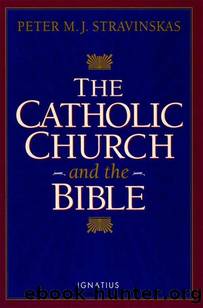The Catholic Church and The Bible by Stravinskas Fr Peter M.J

Author:Stravinskas, Fr Peter M.J. [Stravinskas, Fr Peter M.J.]
Language: eng
Format: epub
Tags: Spiritual & Religion
ISBN: 9780898705881
Publisher: Ignatius Press
Published: 2011-05-02T00:00:00+00:00
Eucharistic Communion
One constant in sacramental terminology down the ages and across denominational lines seems to be the description of the act of eucharistic reception as âHoly Communionâ, and rightly so, for what else more aptly summarizes the meaning of the sacrament? The Roman Missal speaks of Holy Communion as âthe sign and promiseâ of our unity in Christ (CCC 1391, 1402ff.). How is that so?
In both Hebrew and pagan worship, a clear connection was envisioned between the sacrifice offered and the symbolic meal following. Saint Paul reminded the Corinthians that just as the Jews of old were associated with the sacrificial rites by taking the sacrifice into themselves as food, so too do the pagans commune with the demons by participation in their rites. He warned the early Christians, therefore, not to involve themselves in pagan rituals but to restrict themselves to the eucharistic sacrifice and meal, for âThe cup of blessing that we bless, is it not a participation [communion] in the blood of Christ? The bread that we break, is it not a participation in the body of Christ?â (1 Cor 10:16). But thatâs not all; the Eucharist has not only this vertical dimension of union between the believer and Christ but also a horizontal elementâunion among all who receive the sacrament. âBecause the loaf of bread is one, we, though many, are one body, for we all partake of the one loafâ (v. 17; CCC 1396).
Communion with the Lord and with one another occurs as the sacrifice overflows into the meal: the Paschal Lamb is sacrificed for us (and for the whole of humanity) and then eaten, continuing the sacrifice within us, effecting our participation in it. It is no accident that the Lordâs Prayer introduces the Communion Rite, whether that takes place within the Mass or outside it. That prayer, based on the eighteen Benedictions of the Jewish liturgy, admirably combines the vertical and horizontal concerns that should be uppermost in our minds as we endeavor to deepen our union with Christ and each other.
The careful reader will notice that I said âdeepenâ and not âcauseâ. Receiving Holy Communion presupposes an existing relationship with Christ, caused by baptism and restored, if necessary, by sacramental penance (CCC 1385ff., 1415). Hence, Saint Paul cautioned the Corinthians against an unworthy reception of the Eucharist, which would bring on the reverse effects of that for which they hoped (see 1 Cor 11:22ff.). The Fathers of the Church often interpreted Jesusâ parable of the wedding garment as the necessity of being in a state of baptismal innocence to approach the altar. It was surely this rationale that called for catechumens to leave the liturgical celebration before the Offertory (what we once knew as the Mass of the Catechumens, as distinct from the Mass of the Faithful). This understanding is still with us in two ways: the Churchâs insistence on oneâs being in a state of grace to receive Holy Communion and the Churchâs refusal to grant eucharistic Communion to non-Catholic Christians as a general rule (CCC 1398-1400).
Download
This site does not store any files on its server. We only index and link to content provided by other sites. Please contact the content providers to delete copyright contents if any and email us, we'll remove relevant links or contents immediately.
The Lost Art of Listening by Michael P. Nichols(7170)
Why I Am Not A Calvinist by Dr. Peter S. Ruckman(4049)
The Rosicrucians by Christopher McIntosh(3375)
Wicca: a guide for the solitary practitioner by Scott Cunningham(3046)
Signature in the Cell: DNA and the Evidence for Intelligent Design by Stephen C. Meyer(2879)
Real Sex by Lauren F. Winner(2873)
The Holy Spirit by Billy Graham(2782)
To Light a Sacred Flame by Silver RavenWolf(2681)
The End of Faith by Sam Harris(2637)
The Gnostic Gospels by Pagels Elaine(2402)
Waking Up by Sam Harris(2334)
Nine Parts of Desire by Geraldine Brooks(2283)
Jesus by Paul Johnson(2232)
Devil, The by Almond Philip C(2207)
The God delusion by Richard Dawkins(2192)
Heavens on Earth by Michael Shermer(2190)
Kundalini by Gopi Krishna(2094)
Chosen by God by R. C. Sproul(2058)
The Nature of Consciousness by Rupert Spira(1983)
